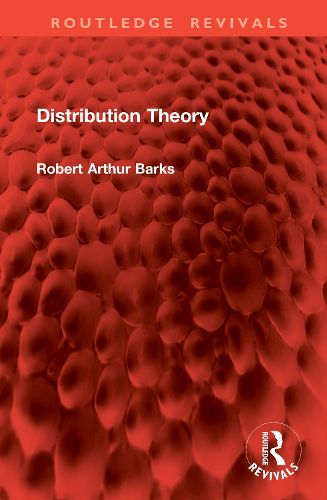Readings Newsletter
Become a Readings Member to make your shopping experience even easier.
Sign in or sign up for free!
You’re not far away from qualifying for FREE standard shipping within Australia
You’ve qualified for FREE standard shipping within Australia
The cart is loading…






First published in 1972, Distribution Theory follows on from the author's earlier book, Descriptive Statistics and Probability Theory, but may easily be followed by any reader who has not studied that particular book but who has gained some knowledge of numerical distributions and basic probability theory. The author has attempted to steer a middle course between those textbooks which concentrate solely on statistical calculations and those which concentrate solely on statistical theory. It is his belief that statistics is best understood through a mixture of practical numerical work and knowledge of the corresponding theory.
In this book, probability distributions are shown to develop out of different physical situations that are commonly met in the physical world. The three most commonly used- the binomial, Poisson, and normal distributions- are dealt in detail, but other less commonly used distributions are also introduced. By showing the different situations to which these distributions apply, their individuality is emphasised. The author then illustrates how these probability distributions are used in sampling theory. The book concludes with a chapter which shows how apparently different parts of statistics can be seen to interrelate through statistical theory. This is an interesting reference work for students of mathematics, statistics and economics.
$9.00 standard shipping within Australia
FREE standard shipping within Australia for orders over $100.00
Express & International shipping calculated at checkout
First published in 1972, Distribution Theory follows on from the author's earlier book, Descriptive Statistics and Probability Theory, but may easily be followed by any reader who has not studied that particular book but who has gained some knowledge of numerical distributions and basic probability theory. The author has attempted to steer a middle course between those textbooks which concentrate solely on statistical calculations and those which concentrate solely on statistical theory. It is his belief that statistics is best understood through a mixture of practical numerical work and knowledge of the corresponding theory.
In this book, probability distributions are shown to develop out of different physical situations that are commonly met in the physical world. The three most commonly used- the binomial, Poisson, and normal distributions- are dealt in detail, but other less commonly used distributions are also introduced. By showing the different situations to which these distributions apply, their individuality is emphasised. The author then illustrates how these probability distributions are used in sampling theory. The book concludes with a chapter which shows how apparently different parts of statistics can be seen to interrelate through statistical theory. This is an interesting reference work for students of mathematics, statistics and economics.